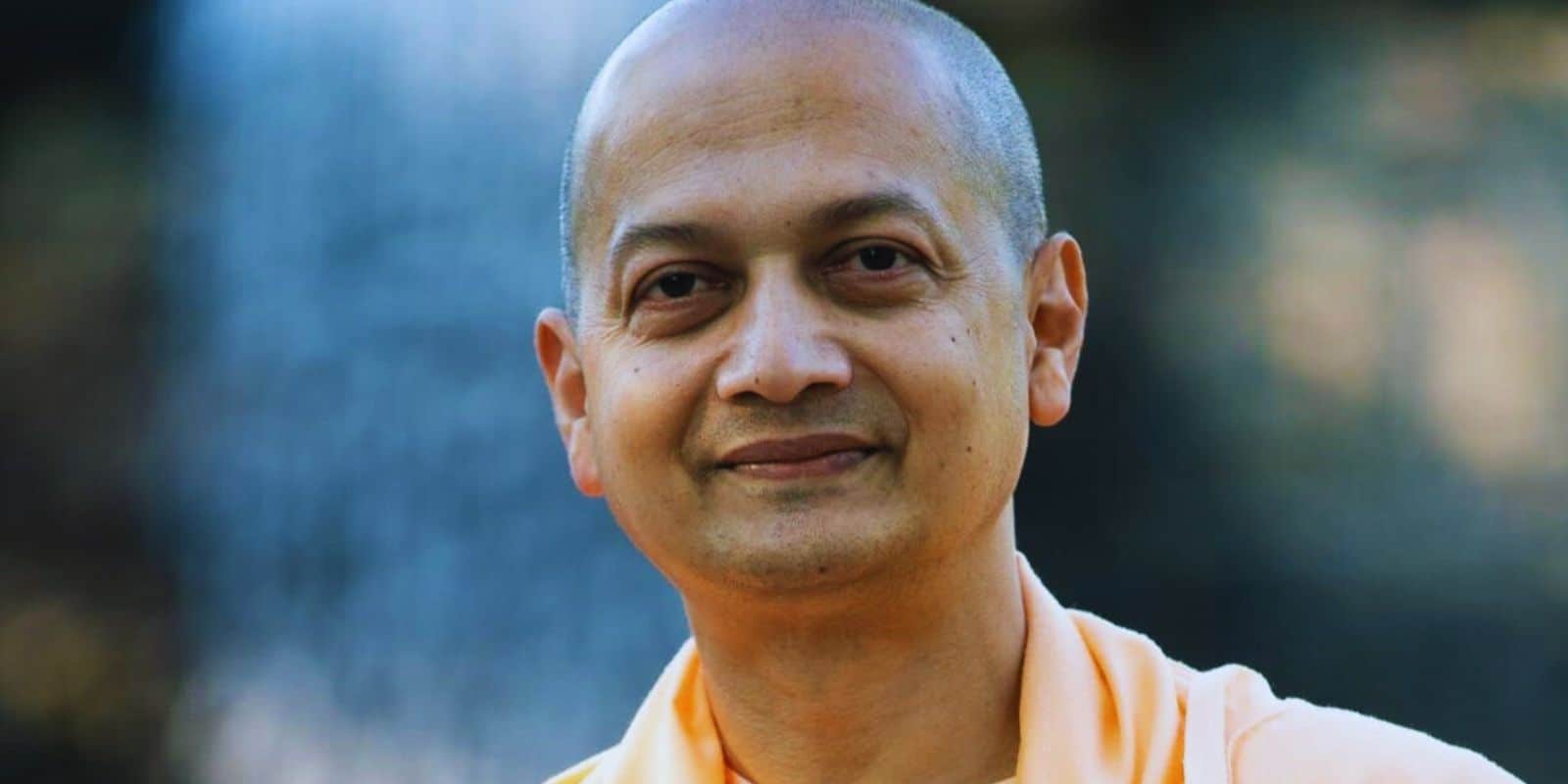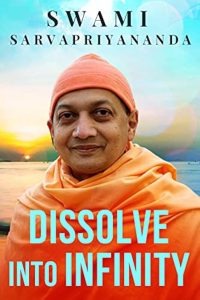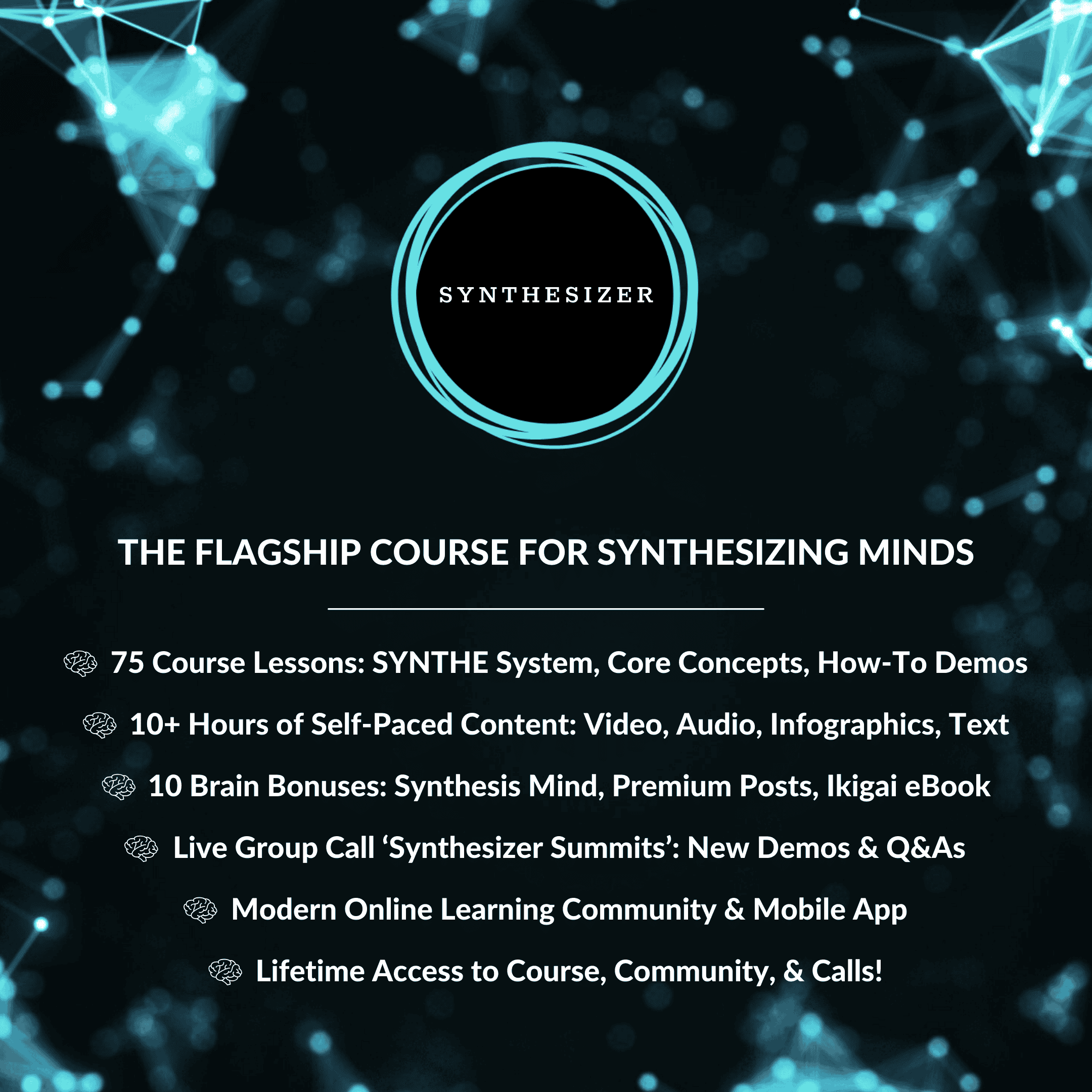This is a book summary of Dissolve into Infinity by Swami Sarvapriyananda (Amazon):
Quick Housekeeping:
- All content in “quotation marks” is from the author (otherwise it’s minimally paraphrased).
- All content is organized into my own themes (not the author’s chapters).
- Emphasis has been added in bold for readability/skimmability.
Book Summary Contents:
- About the Ashtavakra Gita
- Asangatvam: Non-Attachment (Chapter 5 Verse 1)
- Ekatvam: Oneness (Chapter 5 Verse 2)
- Mithyatvam: Falsity/Unreality (Chapter 5 Verse 3)
- Samatvam: Sameness (Chapter 5 Verse 4)

The Ashtavakra Gita: Dissolve into Infinity by Swami Sarvapriyananda (Book Summary)
About the book Dissolve into Infinity
“The Ashtavakra Gita is the most profound thing that has ever been put into words. I have read the sacred literature of the East and the West, and there is nothing that quite compares to this text … This book speaks to something within us which goes beyond the understanding of the mind … While reading this, we must try to understand what is being said, but what is most important is recognizing, appreciating and noticing that it is the truth in our life.”
- “Ashtavakra Gita, also called the Ashtavakra Samhita, is a famous Vedantic text, which imparts the most sublime non-dual truth.”
- “Ashtavakra tells you the central truth that you are none other than God. Tat tvam asi, which translates to ‘That thou art’ – this one teaching is repeated again and again throughout the text.”
- “I will share the four verses from the fifth chapter of this book. The teacher is the great sage Ashtavakra and the student is Emperor Janaka. This chapter is called ‘Four Ways to Dissolution’, where each verse ends with the statement – ‘thus dissolve into infinity’. Each of the four verses is independent, a direct indication of the reality within us. However, there is a progression too. The first three verses delve into the depths of non-duality, and the fourth one is the consequence of the insight gained in the first three.”
Asangatvam: Non-Attachment (Chapter 5 Verse 1)
“You are never attached to anything in this universe, oh pure one, what are you trying to give up? In this way, the body–mind complex dissolves into infinity.”
Non-attachment:
- “The first step is Asangatvam, non-attachment, but not as a practice. It just tells you the real Self you are at this moment, is completely non-attached. It is pure. From the ultimate perspective, there is nothing you can add to it with any kind of spiritual or moral practice which will make it better. There is nothing that you need to get rid of to make it better.”
- “Non-attachment is already an accomplished fact as it is the very nature of our real Self. We have to recognize this great truth … The truth, the consciousness that I am, is unattached to the phenomena which it illumines, including this person, this little life which we think we are. You are not it. This life is just a page in the book of many lifetimes, which you turn over and go to another page, another life. The Atman, the pure consciousness, is experiencing this book of life, and it is not attached to it.”
- “If everything has gone, is going away or will go away, what it means is that nothing sticks to you, you are not attached to anything in this universe. The impermanence of things means you who are experiencing these things that come and go are not attached to anything … You are completely detached from the entire universe of experience.”
Witness consciousness:
- “Ashtavakra tells us that this attachment is a state of the mind … Beyond the mind there is the witness consciousness (Sakshi), which is not attached to anything, not to the world, not to the body, not even to the mind.”
- “You – the witness consciousness – are not attached to anything … not stuck to anything in the body and mind … You are the witness of body and mind, and you are completely unattached to the world, to people, to events, and even to the body, the mind with all its thoughts, ideas and memories.”
- “All phenomena arise in your consciousness, they are experienced in your consciousness and disappear in your consciousness. Consciousness is not attached to any of it.”
Ekatvam: Oneness (Chapter 5 Verse 2)
“The entire universe rises in you like bubbles in an ocean. Know thus the oneness of the self, the entire universe as one reality – You. Dissolve thus into infinity.”
Oneness of the universe/existence:
- “The second step is Ekatvam, where we realize the oneness of all existence … This entire universe that you are experiencing, from which you are detached, and which comes and goes – it comes and goes within you. It is not apart from you. The universe is in you, the universe is you.”
- “Whatever has been experienced, has been experienced in consciousness. That which is experienced in your consciousness is not separate from it – it arises in your consciousness, shines in your consciousness and disappears back into your consciousness.”
- “Pure consciousness, unattached with the particulars of life and the phenomena that arises in the particular life, experiencing them, yet unattached to them, is one with the universal consciousness. The Atman is Brahman. You are Brahman, in which the universe shines.”
It’s all you:
- “In the ocean, there are thousands of waves, separate from each other, big and small, arising and subsiding. There are millions of bubbles each seemingly separate from the other. Yet all those waves and bubbles are but one reality – water … I am an infinite ocean of consciousness, in me all these beings, including this body of mine, they come up like little waves, they play with each other, they fight with each other and they merge back into me again.”
- “Every person you have met, every act you have committed, everything that you say and think, everything that you want or don’t want, those you love, or don’t like, all of these are literally you. It is the consciousness that you are; the universe is one with you.”
- “Not one atom in this universe, not one insect, not one life here is different from you. It is you yourself. It is one life and one consciousness.”
Mithyatvam: Falsity/Unreality (Chapter 5 Verse 3)
“The universe, being unreal, appears like a snake in the rope. It does not exist in you who are pure, even though it is presented to the senses. Dissolve thus into infinity.”
Falsity of the universe:
- “The third step is Mithyatvam, the falsity of the world (the falsity of the universe that appears in you) where we realize the whole universe as an appearance in our Self … You see it but it does not exist independently. So, that which you cannot say that it truly is, and that which you cannot say that it is not, this mixture, which neither exists, nor can be said to be non-existent, this is the false or mithya.”
- “How do we define falsity in Advaita Vedanta? That which ‘borrows’ its reality from something else is false. It does not have an existence of its own … All that appears in the universe, seems to exist. Their existence is borrowed from Brahman, the infinite existence, which is your own Self. The universe borrows its existence from you and appears before you.”
- “False is not non-existent. There is a difference between existent, false and non-existent … That which is false, the universe of appearance, is not non-existent, and it is not truly existent like Brahman; it borrows its existence from the Brahman and then plays before us. Every object that constitutes the universe falls in the category of the false.”
Appearance:
- “The universe does appear in you, which is not denied. You experience your body and your life. He is just saying it is not real. It is an appearance … The world is an appearance in you, the reality … The reality is within us. It is who we really are. The universe is an appearance. The universe appears in thee, it is not real in itself. Look within, not outside.”
- “It appears like a serpent in a rope. The rope is mistaken for a snake. You the Infinite existence consciousness bliss, you are mistaking your real nature for this world. This world is none other than Brahman, this world is none other than you, you do not know this. You know it as the universe, people and a life of suffering and strife, ambition, success and failure, as little stories of every individual’s personal life. Though you see it, it is not real.”
- “That which is in you, which appears in you, is really not in you, it is just an appearance. Only that one Existence, Consciousness, Bliss truly is, and that is what you are. Knowing this, let this universe appear, let the game continue, let birth and death, success and failure occur. Let the waves in the water roll on, the water is not afraid of the waves; the waves arise in the water, play in the water and disappear back into the water.”
Samatvam: Sameness (Chapter 5 Verse 4)
“You are infinite (or complete) in yourself, therefore in pain and in pleasure, you are serene. In hope and despair alike serene. In life and in death alike serene. In this way dissolve into infinity.”
- “Finally, we realize Samatvam, both as the very nature of the Self, and as a great serenity through all the vicissitudes of life.”
- “The consequence of this will be a vast serenity. Serenity is not a quality of the mind, it is the very nature of the Self. When you become aware of that, the mind will also become serene. If there is pain, the mind will experience it, but in the background will be an unchanging serenity.”
- “This background serenity cannot be disturbed, even if you try to disturb it. It is always available to you. Serene in pain, serene in pleasure. Serene in hope, serene in despair. Serene in life, serene in death. The mind will register hope and despair. As life goes on, there will be ups and downs, but that background serenity will always be there, always available to you. From that ultimate perspective, you are always fine, always secure.”
- “Contemplate death – it is only the death of the body. There is no death for you. Once you get an insight into this, it will become clear to you that you are immortal – choicelessly, effortlessly so. You do not have to make yourself immortal – the Self is already immortal, the body can never be immortal. The body will get old, degenerate and die and go back to nature, ashes to ashes and dust to dust. That infinite ocean of awareness and bliss in which the body appeared, that will continue exactly as it has always, and that is what you are. In this way, dissolve into infinity. Not at the time of death, but right now. Dissolving into infinity means that this individuality is dissolved into the infinite and now you live this life from the ultimate perspective.”
You May Also Enjoy:
- Browse all book summaries & book recommendations / reading list





